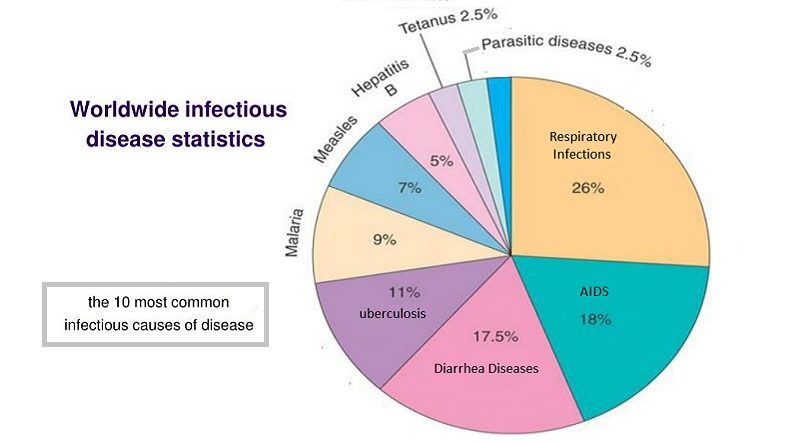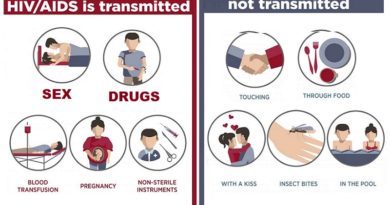10 Most Common Infectious Diseases & How to Prevent Them
In this article, we will explore the ten most common infectious diseases, how they are caused, and how transmitted. In the following paragraphs, we will discuss, in short, the 10 most common infectious diseases and how to prevent them.
Common Infectious Diseases
They are a group of diseases caused by micro-organisms; bacteria, viruses, fungi, protozoa, and helminths. They can be spread from person to person, through contaminated food or water, or through contact with infected animals. Some are mild, such as the common cold while others are life-threatening infections such as AIDS.
The 10 most common infectious diseases:
It’s to mention that this list is not applicable everywhere. The prevalence of these diseases can vary depending on the country’s location and other factors. Some other infectious diseases are common in certain regions but not in others.
by microorganisms such as bacteria, viruses, fungi, and parasites, and spread in different ways
- Influenza (flu)
- COVID-19 (coronavirus)
- Tuberculosis (TB)
- Malaria
- Hepatitis B
- HIV/AIDS
- Dengue fever
- Cholera
- Typhoid fever
- Zika virus
1- Influenza (the flu)
The flu is a respiratory illness caused by the influenza virus. Symptoms include fever, cough, sore throat, runny or stuffy nose, body aches, headache, chills, and fatigue. The flu is highly contagious and can spread through the air when an infected person talks, coughs, or sneezes. To prevent the flu, get vaccinated each year, wash your hands frequently, cover your mouth and nose when coughing or sneezing, and avoid close contact with people who are sick.
2- COVID-19 (coronavirus)
It is caused by corona virus which caused world wide pandemic lasted for 2 years; 2020 and 2021.
3-Tuberculosis (TB)
TB is a bacterial infection that affects the lungs but can also affect other parts of the body. Symptoms include coughing, chest pain, fever, chills, fatigue, and loss of appetite. TB is spread through the air when an infected person talks, coughs, or sneezes. To prevent TB, get vaccinated if you live in an area where TB is common, avoid close contact with people who have TB, and seek medical attention if you have symptoms.
4- Malaria Malaria
is a parasitic infection that is spread by the bite of infected mosquitoes. Symptoms include fever, chills, headache, muscle pain, and fatigue. Malaria is common in tropical and subtropical regions. To prevent malaria, use insect repellent, wear protective clothing, sleep under mosquito nets, and take antimalarial medication if prescribed.
5- Hepatitis B Hepatitis B
is a viral infection that affects the liver. Symptoms include fever, fatigue, abdominal pain, loss of appetite, nausea, and jaundice. Hepatitis B is spread through contact with infected blood or bodily fluids. To prevent hepatitis B, get vaccinated, practice safe sex, and avoid sharing needles, razors, or toothbrushes with others.
6- HIV/AIDS HIV/AIDS
is a viral infection that weakens the immune system, making it difficult for the body to fight off infections and diseases. Symptoms include fever, fatigue, weight loss, night sweats, and recurrent infections. HIV/AIDS is spread through contact with infected blood or bodily fluids. To prevent HIV/AIDS, practice safe sex, use condoms, and avoid sharing needles, razors, or toothbrushes with others.
7- Dengue fever
Dengue fever is a viral infection that is spread by the bite of infected mosquitoes. Symptoms include fever, headache, muscle and joint pain, and a rash. Dengue fever is common in tropical and subtropical regions. To prevent dengue fever, use insect repellent, wear protective clothing, and avoid areas with standing water.
8- Cholera Cholera
is a bacterial infection that affects the intestines. Symptoms include diarrhea, vomiting, and dehydration. Cholera is spread through contaminated food or water. To prevent cholera, drink only clean water, wash your hands frequently, and avoid eating raw or undercooked food.
9- Typhoid fever
Typhoid fever is a bacterial infection that is spread through contaminated food or water. Symptoms include fever, headache, constipation or diarrhea, and abdominal pain. To prevent typhoid fever, drink only clean water, wash your hands frequently, and avoid eating raw or undercooked food.
9- Zika virus
Zika virus is a viral infection that is spread by the bite of infected mosquitoes. Symptoms include fever, rash, joint pain, and conjunctivitis. Zika virus is common in tropical and subtropical regions. To prevent Zika virus, use insect repellent, wear protective clothing, and avoid areas with standing water.
Pneumonia
Pneumonia is a respiratory infection that can be caused by bacteria, viruses, or fungi. Symptoms include fever, cough, chest pain, and difficulty breathing. Pneumonia can be spread through the air when an infected person talks, coughs, or sneezes. To prevent pneumonia, get vaccinated if available, wash your hands frequently, and avoid close contact with people who are sick.
SUMMARY
This article provides a list of the 10 most common infectious diseases, which include flu, COVID-19, malaria, hepatitis B, and others. The prevalence of these diseases can vary depending on geographic location and other factors. We discussed the symptoms, transmission, and treatment options for these diseases. By taking the necessary precautions and practicing good health habits, we can protect ourselves and our communities from these common infectious diseases.
SOURCES
- Cleveland Clinic – “Infectious Diseases”
- Mayo Clinic – “Infectious Diseases”
- Verywell Health – “Tips to Prevent Infections”
- Mayo Clinic – “Germs: Understand and protect against bacteria, viruses and infection”
- WikiHow – “How to Protect Yourself from Infectious Diseases”
- Infectious disease | Definition, Types, & Causes | Britannica



